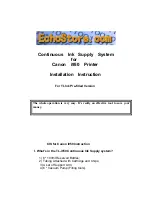
Pro Spectrum User Manual v2.1
33
eyes open and facing the eye tracker.
Maximum gaze angle
The maximum gaze angle for which the eye tracker can perform robust
and accurate tracking on the eyes. The gaze angle is the angle ABC with
A = center of the eye tracker (midpoint between the two eye tracking
sensors), B = eye position (midpoint between the left and the right eye)
and C = stimuli point.
Maximum screen
size
The maximum screen size supported by the standard eye tracker setup
(i.e. mounting the eye tracker directly on the screen).
Monocular calibration
Tracks and reports data for only one eye.
Operating distance
The minimum and maximum distances between the subject’s eyes and
the surface covering the eye tracker sensors at which eye tracking can be
done while maintaining robust tracking.
Optimal conditions
Please download the Data Quality Test Report from
to read
more about optimal conditions for this eye tracker.
Precision
Describes the spatial angular variation between individual and con-
secutive gaze samples (Root Mean Square), calculated on raw data. For
more details on how precision is calculated, please read your eye
tracker's Data Quality Test Report on
Sampling frequency
The number of data samples per second output for each eye. Expressed
in Hz units, where 1 Hz = 1 sample per second.
Total system latency
The duration from the mid-point of the eye image exposure, to when a
sample is available via the API on the client computer. This includes half
of the image exposure time, image read-out and transfer time, pro-
cessing time and time to transfer the data sample to a client computer.
Tracker and client
time synchronization
The eye tracker and software client clocks can drift naturally during oper-
ation. To compensate for this, the Pro SDK will periodically ask the eye
tracker about its current time stamp, noting the system time stamp when
the request is sent and received. This data is then used to calculate how
the system time corresponds to the device time.
Video-based pupil and
corneal reflection eye
tracking
At the center of this technique is a hardware setup that consists of one or
two video cameras and one or multiple sets of infrared-light illuminators.
The cameras capture images of the eyes and the illuminators produce
reflections on its surface. These images are processed by algorithms that
identify the pupil and the reflections caused by the illuminators. This
information is then combined with different parameters from a 3D model
of the eye and used to map the gaze onto the stimulus.
Содержание Pro Spectrum
Страница 1: ...Pro Spectrum User Manual ...


































